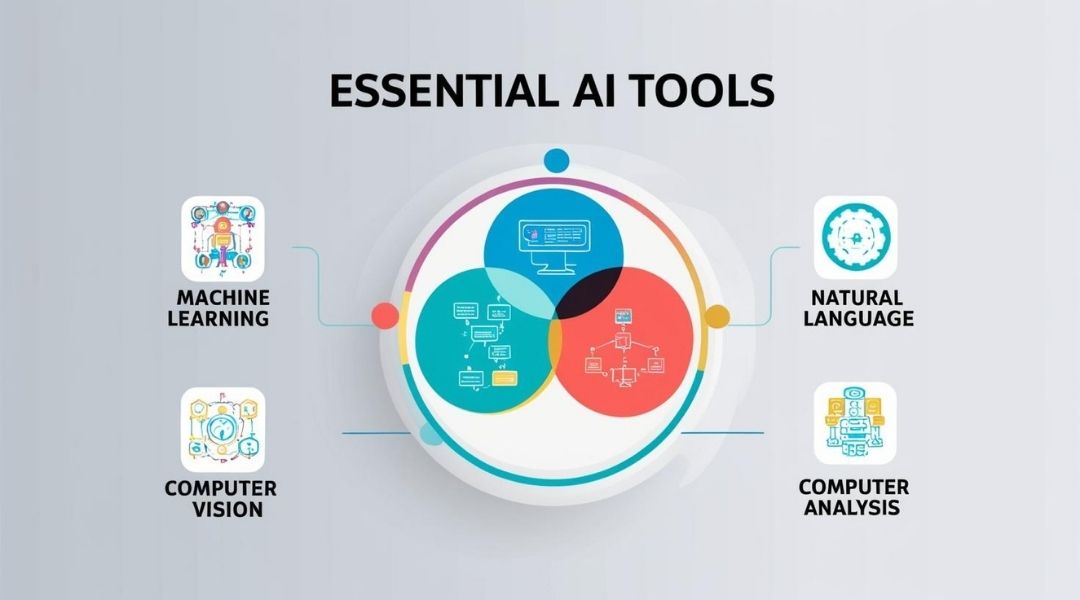Marketers now rely on artificial intelligence to handle everything from content brainstorming to analytics, and over 80% of blogging experts credit automation for reshaping their SEO efforts.
Agencies want to work faster without losing quality. This is especially true since publishers still need to check AI writing for mistakes. Brand scoring, automated link building, and site structure improvements are now easier thanks to modern tools.
Success? It’s time to up our performance; we’re not quite there yet. Expanding our market depends on two things: knowing what people search for locally and optimizing for voice search. It’s that simple. It’s a must to grow.
Foundations begin with AI-powered keyword research tools to sharpen focus and drive measurable results.
AI-powered Keyword Research Tools
AI-powered keyword research tools analyze large data sets to reveal profitable search terms. You can refine your targeting by tapping into insights from real queries. Some marketers report that AI drives their SEO strategy, with 84% seeing better results.
These tools can help you grade your brand performance and monitor competitor tactics. They also identify topic gaps and highlight opportunities for stronger user engagement. You can link data from surveys, sales calls, and customer reviews to refine messaging.
Relevant keywords from these sources help shape your blog posts, website copy, and ads. You still need human review before publishing, since AI-generated suggestions need accuracy checks. Combine them with SEO Vendor’s agency tools for a well-rounded plan in digital marketing.
That synergy boosts brand agility and fosters better performance.
Content Optimization with AI Analysis
Your content calls for precise refinements. AI provides a structured approach that influences rank and benefits visitors.
- Zero-click adaptation: Zero-click searches keep readers on the search page. You need to craft content that stands out beyond those featured responses. AI helps pinpoint sections that address direct questions succinctly. This approach increases engagement metrics and supports consistent site performance.
- AI-driven content scanning: Search providers use natural language processing for clarity. You should prioritize clarity over keyword stuffing. AI highlights phrases that matter most for user satisfaction. Engines reward genuine material that aligns with proven standards.
- Cultivate E-E-A-T: Your personal insight consistently sets you apart online. Readers value material that speaks to their needs. AI can support depth but cannot substitute perspective. Authentic experiences foster trust and advance your overall credibility.
Smart Backlink Building Using AI Software
Use AI-driven link-building platforms to streamline your outreach. This software scans possible partner sites, checks domain authority, and suggests relevant placements. You also get potential outreach messages built from your brand style.
Beginners often appreciate how the software automates tasks from scanning target links to sending messages. Advanced users can optimize by analyzing SERPs to find neutral gaps for relevant placements. You can prompt the tool to gather unique prospects by specifying industry relevance.
This includes anchor text variety. The software can highlight pages with poor text-to-HTML ratios and suggest linking improvements. Some platforms even alert you to newly found domains that match your content’s focus.
That added insight sparks stronger partnerships and timely link acquisition. You maintain control while letting AI do the very heavy lifting with minimal effort.
Automated Rank Tracking and Reporting Systems
These systems help you monitor SEO performance. They present positions and insights with no manual effort.
- Continual updates: You get ranking data at regular intervals. This reveals trends that affect your site’s growth. Many agencies base decisions on real-world results and user feedback for accuracy. Quick corrections help maintain search momentum.
- Integrated dashboards: These pages display keyword shifts and page metrics in one place. You view rankings, traffic changes, and engagement patterns quickly. Better user experience springs from data-driven fine-tuning. Clients appreciate visual charts that show ranking improvements.
- Automated reports: Tools easily email or store scheduled summaries you can share. Clear numbers portray whether SEO moves improve placements on result pages. Real-time tracking sparks faster strategic changes for better outcomes. Detailed logs highlight top pages worth attention.
By using these automated SEO systems, you save time while gaining clearer visibility into your digital progress. With consistent insights and simplified reporting, you’re better equipped to refine strategies, impress clients, and maintain strong search engine performance over time.
Advanced Competitor Analysis Powered by AI
Your competitor analysis taps into AI’s ability to spot patterns in large datasets. It captures competitor strategies, including top-performing pages and user engagement approaches. You discover audience preferences, plus new growth opportunities.
AI pinpoints gaps in their methods. Businesses have reported better campaign performance. They saw a 20% increase in conversion rates after analyzing rivals’ moves.
These insights help shape your content strategy while staying ahead of emerging search topics. You fine-tune offerings that stand out. This method improves your position on search results and maintains steady organic growth.
You pinpoint weaknesses in competitor tactics and gain an advantage without guesswork. AI-based competitor analysis streamlines workflow, frees resources, and boosts ROI in a way. Market data shows 60% of SEO agencies rely on AI insights for results.
Voice Search Trend Monitoring Tools
Voice search usage keeps rising daily. You need advanced tracking tools to see question-based trends.
- Metrics Tracking: These tools track question phrases people speak into devices. They measure local queries across demographics. Many voice prompts link to businesses or needs. Data helps you shape your SEO plan.
- Real Alerts: Frequent updates show voice shifts from seasonal or trending events. Instant alerts help you adapt to sudden changes in question phrases. Swift fixes keep brands seen in evolving voice results. Tracking secures your authority across voice-driven platforms.
- Data Visualization: Clear graphs highlight users who phrase questions in conversation form. These visuals show increases in question-based terms. You detect patterns that shine in the results. Simple charts help you adjust SEO content for voice ranking.
By leveraging advanced tracking tools and visual data, you can stay ahead of voice search trends and tailor your content to match how real people speak. The key is staying flexible; when you adapt quickly, your brand remains visible and relevant in the evolving voice-first landscape.
Image SEO Enhancements Through Artificial Intelligence
You enhance your image performance by using AI solutions that scan, tag, and compress files. These tools help identify optimal alt attributes and suggest keyword-based captions to improve search visibility and faster load times.
Intelligent systems also track visual content performance across multiple digital platforms. They assess user engagement to determine which images resonate most with your audience. This allows you to refine your visual strategy for stronger brand consistency and impact.
Clear alt text ensures search engines understand each image’s purpose, while AI-driven tagging helps your content stand out in crowded feeds. These enhancements boost brand visibility and improve user experience by reducing bounce rates and speeding up page performance.
Altogether, these AI enhancements make your visuals work harder, supporting both SEO goals and a smoother, more engaging user journey.
AI Solutions for Local SEO Strategies
Local success relies on well-crafted methods that capture neighborhood attention. AI steps can guide you toward stronger visibility.
- Data-Focused Research: Machine tools scan user preferences for deeper local targeting. They reveal hidden patterns that boost foot traffic. By 2025, 70% of businesses plan to integrate AI for area analysis. This usage enhances engagement across neighborhoods.
- Local Content Personalization: AI refines local messaging so it speaks to each community. It shapes content style for maximum neighborhood impact. Consumer trust rises when messaging reflects daily needs in each area. Precise data drives relevance without overcomplicating placement.
- Voice-Friendly Adaptation: 58% of consumers use voice assistants to find local shops. AI refines phrasing so users can speak confidently. They deliver quick answers for voice queries. Better results spark more repeat visits and stronger local credibility for your brand.
With AI-driven strategies, your brand can connect more authentically with local audiences. By combining smart data, personalized messaging, and voice-ready content, you build lasting visibility where it matters most, right in your community.
Predictive Analytics to Forecast Traffic Trends
You rely on predictive analytics to spot hidden clues in search and user data. This method learns from past traffic shifts and evolving search behaviors. It helps you identify possible spikes in volume and plan timely campaigns.
You can project a 10% lift in sessions. Focus on topics that match seasonal interest. It also allows you to fine-tune your posting schedule.
Many SEO experts use AI-driven insights. They detect new user questions before they explode in popularity. You see where to add more pages or update existing ones.
This approach strengthens your content roadmap and boosts your ranking. It also reduces guesswork, saving resources on strategies that will not yield results. Frequent checks of these predictive reports keep you flexible and prepared.
Adopting specialized AI tools in 2025 will give SEO agencies an edge. Automated keyword analysis, next-level content creation, and voice search optimization highlight a bright future. Some might feel nervous about technology changes and trust.
Those who embrace machine learning strategies see productivity climb by up to 40%. Tools that predict ranking shifts can spare teams from last-minute scrambles. This path helps agencies respond to fresh competition and changing client needs.
Being open to new solutions sets agencies on a faster route to top-tier results. That synergy sparks big wins.









